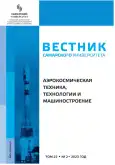New methods for identifying diagnostic indicators of the technical condition of aircraft gas turbine engine reduction gearboxes
- Authors: Sundukov A.Y.1, Shakhmatov Y.V.2
-
Affiliations:
- PKF TSK, LLC
- Samara National Research University
- Issue: Vol 22, No 2 (2023)
- Pages: 105-115
- Section: MECHANICAL ENGINEERING
- URL: https://journal-vniispk.ru/2542-0453/article/view/145848
- DOI: https://doi.org/10.18287/2541-7533-2023-22-2-105-115
- ID: 145848
Cite item
Full Text
Abstract
Planetary gearboxes of aviation gas turbine engines are their most stressed units. Control of their technical condition under operating conditions by measuring the oil temperature and the presence of chips in it by a visual endoscopic method does not provide the required completeness of control. High vibration activity of gearboxes, especially in case of development of a widespread defect in the form of wear of tooth flanks, requires additional methods of assessment of their technical condition. The practice of operating such complex and stressed objects shows that vibroacoustic diagnostics is the most effective one. However, for aviation gas-turbine engines its use is connected with certain difficulties. First of all, it is the change of vibration intensity when the engine is relocated from the test bench to the object. At the engine manufacturer's stand, as a rule, the collection of experimental material for the development of methods of vibration-based diagnostics of defects is carried out. To overcome the above-mentioned problem, we suggest new methods for detecting diagnostic signs of tooth flank wear. Both vibration processes and signals of “standard” tachometric sensors of input and output gearbox shaft rotation frequency are used. A set of diagnostic features on the basis of frequency parameters is proposed. The use of some of them makes it possible to assess the technical condition of the engine gearbox during operation, for example in the performance of routine maintenance work.
About the authors
A. Ye. Sundukov
PKF TSK, LLC
Author for correspondence.
Email: sunduckov@mail.ru
Candidate of Science (Engineering), Director
Russian FederationYe. V. Shakhmatov
Samara National Research University
Email: shakhm@ssau.ru
Academician of the Russian Academy of Sciences, Head of the Department of Power Plant Automatic Systems
Russian FederationReferences
- Avramenko A.A., Kryuchkov A.N., Plotnikov S.M., Sundukov E.V., Sundukov A.E. Refining methods of vibration diagnostics of wear of turbo-prop engine differential speed reduction unit gear teeth. Vestnik of Samara University. Aerospace and Mechanical Engineering. 2018. V. 17, no. 3. P. 16-26. (In Russ.). DOI: 10. 18287/2541-7533-2018-17-3-16-26
- Kurushin M.I., Balyakin V.B., Kurushin A.M. Experimental investigation of the courses of vibration excitation of elements of gas turbine engines with a differential reduction gearbox. Izvestiya Samarskogo Nauchnogo Tsentra RAN. 2014. V. 16, no. 4. P. 132-136. (In Russ.)
- Nerazrushayushchiy kontrol'. Spravochnik v 7 t. T. 7, kn. 2. Vibrodiagnostika / pod red. V.V. Klyueva [Nondestructive testing: Handbook. In 7 volumes. V. 7. Book 2. Vibration-based diagnostics / ed. by V.V. Klyuev]. Moscow: Mashinostroenie Publ., 2005. 828 p.
- Skeinik R., Petersen D. Automated fault detection via selective frequency band alarming in PC-based predictive maintenance systems. CSI, Knaxville, TN 37923, USA.
- Maslov G.A., Mitenkov V.B. Evaluation of the aircraft vibration characteristics using high-torque statistic in the case of limited experiments. Aerospace MAI Journal. 2014. V. 21, no. 2. P. 13-17. (In Russ.)
- Decker H.J. Crack detection for aerospace quality spur gears. International 58th Annual Forum and Technology Display sponsored by the American Helicopter Society (June, 11-13, 2002, Montreal, Quebec, Canada). Available at: https://ntrs.nasa.gov/citations/20020061785
- Kirsis T.Т., Martin H.R. Gear pump defect detection under light loading conditions. Fluidics Quarterly. 1978. V. 10, Iss. 4. Р. 73-89.
- Aatola S., Leskinen R. Cepstrum analysis predicts gearbox failure. Noise Control Engineering Journal. 1990. V. 34, Iss. 2. Р. 53-59. doi: 10.3397/1.2827757
- Bоard D.B. Incipient failure detection for helicopter drive trains. 13th Propulsion Conference (July, 11-13, 1977, Orlando, FL, U.S.А.). doi: 10.2514/6.1977-898
- Dyer D., Stewart R.М. Detection of rolling element bearing damage by statistical vibration analysis. Journal of Mechanical Design, Transactions of the ASME. 1978. V. 100, Iss. 2. Р. 229-235. DOI: 10.1115/1. 3453905
- Sokolova A.G. New noise – immune incipient failure detection metods for machinery monitoring and protection systems. 5-th International Conference on Vibration Problems (October, 8-10, 2001, Moscow, Russia). Abstracts. Moscow: IMASH Publ., 2001. Р. 48-53. (In Russ.)
- Randall R.B. Cepstrum analysis. Machine health monitoring using vibration analysis. Canadian Acoustical Association (October, 17-21, 1983, Vancouver, Сanada). Р. 3-15.
- Harting D.R. Demodulated resonance analysis – A powerful incipient failure detection technique. ISA Transactions. 1978. V. 17, Iss. 1. Р. 35-40.
- Vul' V.M., Popkov V.I., Agafonov V.K., Baklanov V.S. Issledovanie dinamicheskikh kharakteristik dvigatelya, stenda i ob"ekta v mestakh opornykh svyazey. Sb. trudov «Vibratsionnaya prochnost' i nadezhnost' dvigateley i sistem letatel'nykh apparatov». Iss. 7. Kuybyshev: Kuybyshev Aviation Institute Publ., 1980. P. 62-68. (In Russ.)
- Sundukov A.E., Sundukov E.V., Bit-Zaya A.V., Roslyakov A.V. Evaluation of the width of the discrete components of the spectrum of vibration energy machines. Izvestiya Sa-marskogo nauchnogo tsentra RAN. Spets. vypusk «Problemy zheleznodorozhnogo transporta na sovremennom etape razvitiya». 2006. P. 194-197. (In Russ.)
- Sokolov G.A., Sagitov R.V. Vvedenie v regressionnyy analiz i planirovanie regressionnykh eksperimentov v ekonomike: ucheb. posobie [Introduction to regression analysis and designing regression experiments in economics]. Moscow: INFRA-M Publ., 2010. 202 p.
- Sundukov A.E. Sposob diagnostiki defektov zub'ev zubchatykh koles reduktora gazoturbinnogo dvigatelya [Diagnostic method for defects of teeth of geared wheels of reduction gear of gas turbin eengine]. Patent RF, no. 2737993, 2020. (Publ. 07.12.2020, bull. no. 34)
- Sundukov A.E. Sposob izmereniya energeticheskoy shiriny spektral'noy sostavlyayushchey vibratsii mashin [Method for measuring energy width of spectral component of machine vibration]. Patent RF, no. 2750846, 2021. (Publ. 05.07.2021, bull. no. 19)
- Kozharinov E.V., Kalinin D.V., Golovanov V.V. Reduction of aviation gear’s vibration. Aviation Engines. 2020. No. 1 (6). P. 57-64. (In Russ.) doi: 10.54349/26586061_2020_1_57
- Sundukov A.E. Sposob diagnostiki defektov zub'ev zubchatykh koles reduktora gazoturbinnogo dvigatelya [Method for diagnostics of defects of gears of gear wheels of gearbox of gasturbine engine]. Patent RF, no. 2783467, 2022. (Publ. 14.11.2022, bull. no. 32)
Supplementary files









